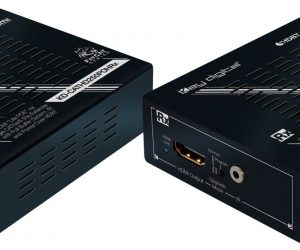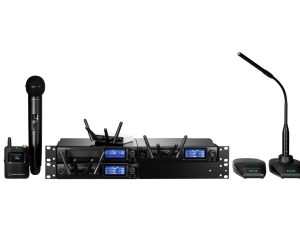
Green-Go Digital Intercom
Talkback and cueing over Ethernet.
Review:/ Paul Barrett
The Green-GO system may be less than a year old, but as it’s designed and manufactured in Holland by DMX specialists ELC Lighting, and its prototype has already won innovation awards at the 2011 PLASA and LDI shows, my expectations as I unboxed the system were high.
Green-GO is a digital communications system based on Ethernet, making use of regular Cat5/6 UTP cable and network switches capable of providing Power over Ethernet (PoE). But the most surprising part is this system has no central matrix or controller.
I had been told the system would work on a regular office network straight out of the box, provided your office network provides PoE, which is becoming more common with the wide adoption of Voice Over IP (VoIP) phones. So grabbing two of the GBP2 two-channel beltpacks and headsets with standard four-pin XLR cables, I plugged a Cat5 cable to each and around four seconds later was presented with ‘All’ as one of my two channel options on each pack. So far, so good. Before I could say anything, my 14-year-old assistant had the microphone on and was talking to me: clearly the controls are obvious.
The audio quality is wonderful with its 16kHz sample rate and 16-bit dynamic range, but more impressive is the low, 12ms latency, equal to around only four metres of sound travel through air. This is a real winner, as many digital communications systems have latency more than double that, which becomes a real issue when users are within hearing distance of each other.
Adding the MCD8 eight-channel desk to the system is just as easy, with the channels auto-populated with the labels All, Sound, Light, Stage, etc. This unit has a local speaker and a gooseneck microphone option, as well as general purpose inputs and outputs (GPI/O), and external audio input and output. A nice touch is the second network port for connecting other network devices such as a laptop, to look after system configuration. Not that you need a laptop to get basic functionality, as the default configuration contains 60 user profiles with names like Stage Manager and Camera 1 as well as groups such as Lights and Sound.
One of the functions that separates Green-GO from traditional partyline systems is the ability to create point-to-point or one-to-one conversations in addition to the traditional talk groups. This gives the system functionality similar to that of a gout-wire matrix system, especially when combined with the soon-to-be-released two-wire (think: traditional partyline) and four-wire analogue interface units. These units should allow Green-GO to be integrated with any existing communications system – especially useful if you can’t afford to upgrade your entire facility in one hit.
MORE INFO
PRICE
GBP2 Beltpack: $1495 (inc GST)
MCD8 8-channel controller: $4275 (inc GST)
CONTACT
Hills SVL: (02) 9647 1411 or www.hillssvl.com.au
Green-GO: www.greengocom.com

DID I MENTION IT’S ALSO A CUE-LIGHT SYSTEM?
The desktop multichannel desks can also double as a cue-light controller for any other unit, or group of units, on the network. Simply select Cue and the User or Group you wish to place on standby and the display button on the associated beltpacks will flash orange, awaiting acknowledgement. Once acknowledged, the display changes to Red for Standby. It then changes to Green for Go when the cue button is pressed (hence the name). There is also a dedicated wall-mount cue-light-only station, the GWP. This cue-light function alone may be enough for many theatres or rental companies to make the jump; as dedicated cue-light systems can be quite costly and are frequently under-utilised.
Of course if you wish to configure custom users or groups you will need to get out the laptop (Mac or Windows), plug into the network, check your network settings are set to DHCP (Dynamic Host Configuration Protocol) and load up the free configuration software. All the Green-GO devices on the network will soon be discovered and listed in the Devices window. Green-GO claim that as many as 3750 devices may co-exist on one network, and with that many units, the search function will be very handy.
From this screen you can upload the current configuration from any device on the network, that’s right, as there is no central controller, every device on the network contains a copy of the configuration. Alternatively, you could start with a blank slate and create your own. When assigning channels to each user you can select from up to 250 Groups for partyline conversations or any individual device to create a direct point-to-point conversation. The software is incredibly easy to use and barely requires a manual – simple and to the point.
You may have noticed that even though this is an Ethernet-based device, at no point have I had to deal with a single IP address, as Green-GO does not require an assigned IP address for normal operation. This has the dual benefit of making it super easy to deploy and avoids the possibility of an address conflict should you be sharing the network with other devices.
On the matter of sharing networks, not surprisingly, Green-GO was designed from the onset to coexist with lighting and audio products, but do not try to share an Ethersound network. Network traffic is claimed to be 340 kilobits per second for each active microphone or other audio input. That’s less then 0.4% of the capacity of a standard 100 megabits per second network, so unless you have a large system with everybody talking at once, it’s unlikely to be a bandwidth hog. One important point, however, is it will not work over a wireless connection. This will certainly be down to a latency issue, something common to many audio over Ethernet solutions.

SO WHAT DO I THINK?
Of course Ethernet is not the magic bullet for all situations. If your existing network does not provide PoE then additional power injectors will be required. The lack of loop-thru on the beltpacks will disappoint some users, as will the Cat5/6 cable length limit of 100m (from network switch to device). Using Ethernet in larger venues will require either fibre optic runs or additional PoE switches such as the Green-GO GGS5 5-port PoE switch.
While Green-GO has not (yet anyway) got the full complement of interfaces or the depth of configuration required for something of the scale of an Olympic opening ceremony, it is a fantastically simple system for anyone who already has an Ethernet network, or for users who want more functionality than a regular beltpack system (think cue-lights) without the expense of a central matrix/controller. Add to that a product line that will soon include desktop stations with up to 32 channels, wall-mount stations and analogue interfaces, and I doubt it will be long before we see Green-GO units on networks around the country.















RESPONSES